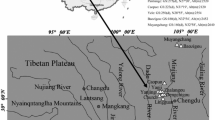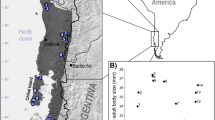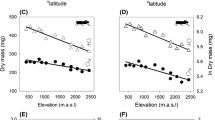Abstract
Animal body size often varies systematically along latitudinal gradients, where individuals are either larger or smaller with varying season length. This study examines ecotypic responses by the generalist grasshopper Melanoplus femurrubrum (Orthoptera: Acrididae) in body size and covarying, physiologically based life history traits along a latitudinal gradient with respect to seasonality and energetics. The latitudinal compensation hypothesis predicts that smaller body size occurs in colder sites when populations must compensate for time constraints due to short seasons. Shorter season length requires faster developmental and growth rates to complete life cycles in one season. Using a common garden experimental design under laboratory conditions, we examined how grasshopper body size, consumption, developmental time, growth rate and metabolism varied among populations collected along an extended latitudinal gradient. When reared at the same temperature in the lab, individuals from northern populations were smaller, developed more rapidly, and showed higher growth rates, as expected for adaptations to shorter and generally cooler growing seasons. Temperature-dependent, whole organism metabolic rate scaled positively with body size and was lower at northern sites, but mass-specific standard metabolic rate did not differ among sites. Total food consumption varied positively with body size, but northern populations exhibited a higher mass-specific consumption rate. Overall, compensatory life history responses corresponded with key predictions of the latitudinal compensation hypothesis in response to season length.






Similar content being viewed by others
References
Alho JS, Herczeg G, Soderman F, Laurila A, Jonsson KI, Merila J (2010) Increasing melanism along a latitudinal gradient in a widespread amphibian: local adaptation, ontogenic or environmental plasticity? BMC Evol Biol 10:317
Angilletta MJJ (2009) Thermal adaptation: a theoretical and empirical synthesis. Oxford University Press, New York
Angilletta MJ, Sears MW, Steury TD (2003) Temperature, growth rate, and body size in ectotherms: fitting pieces of a life history puzzle. Integr Comp Biol 44:498-509
Arnett AE, Gotelli NJ (1999a) Bergmann’s rule in the ant lion Myrmeleon immaculatus DeGeer (Neuroptera: Myrmeleontidae): geographic variation in body size and heterozygosity. J Biogeogr 26:275–283
Arnett AE, Gotelli NJ (1999b) Geographic variation in life-history traits of the ant lion, Myrmeleon immaculatus: evolutionary implications of Bergmann’s rule. Evolution 53:1180–1188
Atkinson D, Sibly RM (1997) Why are organisms usually bigger in colder environments? Making sense of a life history puzzle. Trends Ecol Evol 12:235–239
Ayres MP, Scriber JM (1994) Local adaptation to regional climates in Papilio canadensis (Lepidoptera, Papilionidae). Ecol Monogr 64:465–482
Bailey CG, Mukerji MK (1977) Energy dynamics of Melanoplus bivitattus and Melanoplus femurrubrum (Orthoptera Acrididae) in a grassland ecosystem. Can Entomol 109:605–614
Beckerman AP (2002) The distribution of Melanoplus femurrubrum: fear and freezing in Connecticut. Oikos 99:131–140
Behmer ST, Joern A (2008) Coexisting generalist herbivores occupy unique nutritional feeding niches. Proc Natl Acad Sci 105:1977–1982
Bidau CJ, Marti DA (2007a) Clinal variation of body size in Dichroplus pratensis (Orthoptera: Acrididae): inversion of Bergmann’s and Rensch’s rules. Ann Entomol Soc Am 100:850–860
Bidau CJ, Marti DA (2007b) Dichroplus vittatus (Orthoptera: Acrididae) follows the converse to Bergmann’s rule although male morphological variability increases with latitude. Bull Entomol Res 97:69–79
Bidau CJ, Marti DA (2008) Geographic and climatic factors related to a body-size cline in Dichroplus pratensis Bruner, 1900 (Acrididae, Melanoplinae). J Orthoptera Res 17:149–156
Blackburn TM, Gaston KJ, Loder N (1999) Geographic gradients in body size: a clarification of Bergmann’s rule. Divers Distrib 5:165-174
Blanckenhorn WU, Demont M (2004) Bergmann and converse Bergmann latitudinal clines in arthropods: two ends of a continuum? Integr Comp Biol 44:413–424
Branson DH (2004) Relative importance of nymphal and adult resource availability for reproductive allocation in Melanoplus sanguinipes (Orthoptera: Acrididae). J Orthoptera Res 13:239–245
Brose U (2010) Body-mass constraints on foraging behaviour determine population and food-web dynamics. Funct Ecol 24:28–34
Brown JH, Gillooly JF, Allen AP, Savage VM, West GB (2004) Toward a metabolic theory of ecology. Ecology 85:1771–1789
Calder WAI (1984) Size, function and life history. Harvard University Press, Cambridge
Capinera JL, Scott RD, Walker TJ (2004) Field guide to grasshoppers, katydids, and crickets of the United States. Comstock, Ithaca
Cease AJ, Hao S, Kang L, Elser JJ, Harrison JF (2010) Are color or high rearing density related to migratory polyphenism in the band-winged grasshopper, Oedaleus asiaticus? J Insect Physiol 56:926–936
Chappell MA (1982) Metabolism and thermoregulation in desert and montane grasshoppers. Oecologia 56:126–131
Chappell MA, Whitman DA (1990) Grasshopper thermoregulation. In: Chapman RF, Joern A (eds) Biology of grasshoppers. Wiley Interscience, New York
Chown SL, Gaston KJ (1999) Exploring links between physiology and ecology at macro-scales: the role of respiratory metabolism in insects. Biol Rev 74:87–120
Chown SL, Gaston KJ (2010) Body size variation in insects: a macroecological perspective. Biol Rev 85:139–169
Chown SL, Klok CJ (2003) Altitudinal body size clines: latitudinal effects associated with changing seasonality. Ecography 26:445–455
Chown SL, Nicolson SW (2004) Insect physiological ecology: mechanisms and patterns. Oxford University Press, New York
Clusella Trullas S, van Wyk JH, Spotila JR (2007) Thermal melanism in ectotherms. J Therm Biol 32:235–245
Conover DO, Present TMC (1990) Countergradient variation in growth rate: compensation for length of the growing season among Atlantic silversides from different latitudes. Oecologia 83:316–324
De Block M, Slos S, Johansson F, Stoks R (2008) Integrating life history and physiology to understand latitudinal size variation in a damselfly. Ecography 31:115–123
Dingle H, Mousseau TA (1994) Geographic-variation in embryonic-development time and stage of diapause in grasshopper. Oecologia 97:179–185
Dingle H, Mousseau TA, Scott SM (1990) Altitudinal variation in life cycle syndromes of California populations of the grasshopper, Melanoplus sanguinipes (F). Oecologia 84:199–206
Fielding DJ, Defoliart LS (2005) Density and temperature-dependent melanization of fifth-instar Melanoplus sanguinipes: interpopulation comparisons. J Orthoptera Res 14:107–113
Fielding DJ, Defoliart LS (2007) Growth, development, and nutritional physiology of grasshoppers from subarctic and temperate regions. Physiol Biochem Zool 80:607–618
Forsman A (1999) Variation in thermal sensitivity of performance among colour morphs of a pygmy grasshopper. J Evol Biol 12:869–878
Gillooly JF, Brown JH, West GB, Savage VM, Charnov EL (2001) Effects of size and temperature on metabolic rate. Science 293:2248–2251
Grant A, Hassall M, Willott SJ (1993) An alternative theory of grasshopper life-cycles. Oikos 66:263–268
Hadley NF, Massion DD (1985) Oxygen consumption, water loss and cuticular lipids of high and low elevation populations of the grasshopper Aeropedellus clavatus (Orthoptera: Acrididae). Comp Biochem Physiol A 80A:307–311
Harrison JF, Fewell JH (1995) Thermal effects on feeding-behavior and net energy-intake in a grasshopper experiencing large diurnal fluctuations in body-temperature. Physiol Zool 68:453–473
Ho CK, Pennings SC, Carefoot TH (2010) Is diet quality an overlooked mechanism for Bergmann’s rule? Am Nat 175:269–276
Huston MA, Wolverton S (2011) Regulation of animal size by eNPP, Bergmann’s rule, and related phenomena. Ecol Monogr 81:349–405
Irlich UM, Terblanche JS, Blackburn TM, Chown SL (2009) Insect rate-temperature relationships: environmental variation and the metabolic theory of ecology. Am Nat 174:819–835
Joern A (1981) Importance of behavior and coloration in the control of body-temperature by Brachystola magna Girard (Orthoptera, Acridiae). Acrida 10:117–130
Kemp WP (1986) Thermoregulation in three rangeland grasshopper species. Can Entomol 118:335–343
Kivelä SM, Välimäki P, Carrasco D, Mäenpää MI, Oksanen J (2011) Latitudinal insect body size clines revisited: a critical evaluation of the saw-tooth model. J Anim Ecol 80:1184–1195
Lighton JRB (2008) Measuring metabolic rates: a manual for scientists. Oxford University Press, New York
Logan JD, Joern A, Wolesensky W (2003) Chemical reactor models of optimal digestion efficiency with constant foraging costs. Ecol Model 168:25–38
Masaki S (1967) Geographic variation and climatic adaptation in a field cricket (Orthoptera: Gryllidae). Evolution 21:725–741
Massion DD (1983) An altitudinal comparison of water and metabolic relations in two acridid grasshoppers (Orthoptera). Comp Biochem Physiol A 74A:101–105
Mousseau TA (1997) Ectotherms follow the converse to Bergmann’s rule. Evolution 51:630–632
Mousseau TA, Roff D (1989) Adaptation to seasonality in a cricket: patterns of phenotypic and genotypic variation in body size and diapause expression along a cline of season length. Evolution 43:1483–1496
Parsons SMA (2011) A generalist grasshopper species (Melanoplus femurrubrum) is adapted to variable environments along a latitudinal gradient. M.S. thesis. Division of Biology, Kansas State University, Manhattan
Present TMC, Conover DO (1992) Physiological basis of latitudinal growth differences in Menidia menidia: variation in consumption or efficiency? Funct Ecol 6:23–31
Raubenheimer D, Simpson SJ (1994) The analysis of nutrient budgets. Funct Ecol 8:783–791
Roff D (1980) Optimizing development time in a seasonal environment: the ups and downs of clinal variation. Oecologia 45:202–208
Roff D (1992) The evolution of life histories: theory and analysis. Chapman & Hall, New York
Salgado CS, Pennings SC (2005) Latitudinal variation in palatability of salt-marsh plants: are differences constitutive? Ecology 86:1571–1579
Shelomi M (2012) Where are we now? Bergman’s rule sensu lato in insects. Am Nat 180:511–519
Simpson SJ, Raubenheimer D (1993) A multilevel analysis of feeding-behavior: the geometry of nutritional decisions. Philos Trans R Soc Lond Ser B Biol Sci 342:381–402
Simpson SJ, Simpson CL (1989) The mechanisms of compensation by insect herbivores. In: Bernays EA (ed) Insect–plant interactions, vol 2. CRC, Boca Raton
Terblanche JS, Chown SL (2010) Effects of flow rate and temperature on cyclic gas exchange in tsetse flies (Diptera, Glossinidae). J Insect Physiol 56:513–521
Terblanche JS, Janion C, Chown SL (2007) Variation in scorpion metabolic rate and rate-temperature relationships: implications for the fundamental equation of the metabolic theory of ecology. J Evol Biol 20:1602–1612
Thompson DB (1999) Genotype-environment interaction and the ontogeny of diet-induced phenotypic plasticity in size and shape of Melanoplus femurrubrum (Orthoptera: Acrididae). J Evol Biol 12:38–48
Thompson JN (2005) The geographic mosaic of coevolution. The University of Chicago Press, Chicago
Vickery VR, Kevan DK McE (1986) The grasshoppers, crickets, and related insects of Canada and adjacent regions: Ulonata, Dermaptera, Cheleutoptera, Notoptera, Dictuoptera, Grylloptera, and Orthoptera. Biosystematics Research Institute, Ottawa
Whitman DW (2008) The significance of body size in the Orthoptera: a review. J Orthoptera Res 17:117–134
Willott SJ (1997) Thermoregulation in four species of British grasshoppers (Orthoptera: Acrididae). Funct Ecol 11:705–713
Woods HA, Kingsolver JG (1999) Feeding rate and the structure of protein digestion and absorption in lepidopteran midguts. Arch Insect Biochem Physiol 42:74–87
Yang Y, Joern A (1994a) Compensatory feeding in response to variable food quality by Melanoplus differentialis. Physiol Entomol 19:75–82
Yang YL, Joern A (1994b) Influence of diet quality, developmental stage, and temperature on food residence time in the grasshopper Melanoplus differentialis. Physiol Zool 67:598–616
Zera AJ, Harshman LG (2002) The physiology of life history trade-offs in animals. Annu Rev Ecol Syst 32:95–126
Acknowledgments
A. N. Laws, W. K. Dodds and J. Reese kindly provided comments on the manuscript. We thank J. Nippert for assistance, T. Grace for discussions about spectral analysis, F. Dowell and E. Maghirang at the USDA-ARS Center for Grain and Animal Health Research for use of the spectrometer for spectral analysis, and C. Shannon for statistical advice. Comments by anonymous reviewers greatly improved the manuscript. This work was funded in-part by the Division of Biology, National Science Foundation (NSF) Long-Term Ecological Research, the Institute for Grassland Studies, and NSF DEB-0456522. This is Kansas Agricultural Experimental Station publication 14-096-J.
Author information
Authors and Affiliations
Corresponding author
Additional information
Communicated by Roland A. Brandl.
Electronic supplementary material
Below is the link to the electronic supplementary material.
Rights and permissions
About this article
Cite this article
Parsons, S.M.A., Joern, A. Life history traits associated with body size covary along a latitudinal gradient in a generalist grasshopper. Oecologia 174, 379–391 (2014). https://doi.org/10.1007/s00442-013-2785-6
Received:
Accepted:
Published:
Issue Date:
DOI: https://doi.org/10.1007/s00442-013-2785-6




